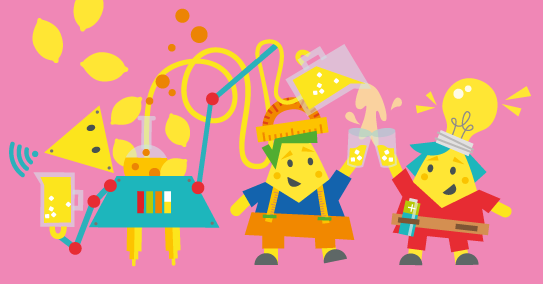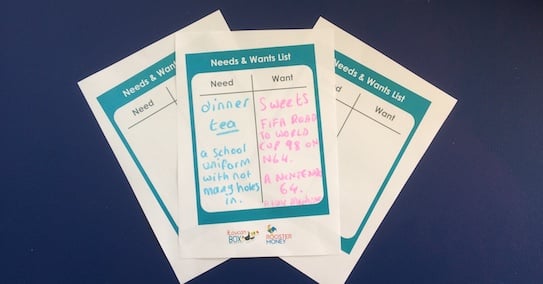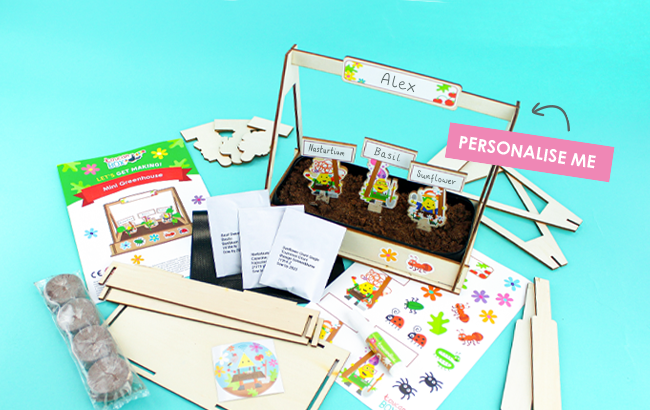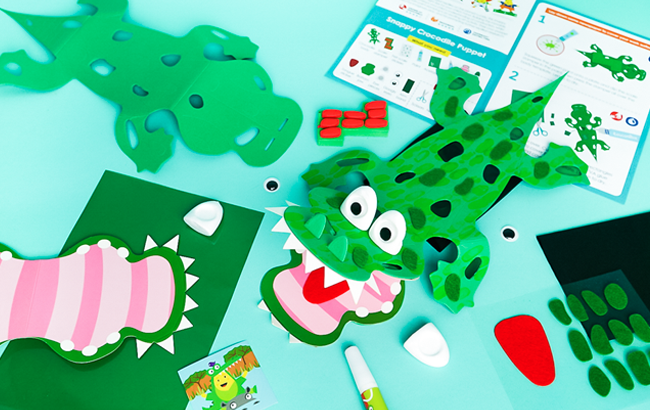5 Crafty Ways To Help Kids Learn About Money

Learning how to handle money is tricky. So tricky that a lot of adults have still yet to master it. So teaching children how to deal with money can seem like a real minefield. Not only do you have to educate them about handling coins and notes, and addition and subtraction, but you also have to teach about physical money vs digital money, saving and planning ahead, and about how it definitely does not grow on trees.
Thankfully, to navigate said minefield toucanBox has teamed up with RoosterMoney to dream up five fantastic money teaching activities to do at home, resulting in hands-on challenges, engaging discussions and a lot of money-based learning. Plus, find out how you can get 25% off an annual subscription to RoosterMoney the pocket money app..
1 / Lemonade Stand
It’s a classic. Set up a mini-shop outside your home for the afternoon and encourage the kids to sell cups of lemonade. You’ll just need a table, some signs, paper cups and a fair bit of elbow grease to squeeze all of those lemons.
What to do
First you need something to sell. In this case, we could be talking about either literal of metaphorical lemonade. You could do a bake sale, crisp stop or sandwich shack; it’s really up to you. But in the summer sun, nothing’s better than a cooling glass of lemonade.
You’ll need some sparkling water, sugar, ice and a whole lot of lemons. Squeeze the lemons in a jug, add some sugar (we recommend about 1 tablespoon for every 4 lemons), sparkling water and ice. You could add a touch of class with some sliced lemons.
Once you’ve got your product, you’ll need your stall. A pasting table or garden table would work well. You might want to dress it up with a tablecloth, and add some signs. The signs should tell your customers what’s for sale, and how much it is.
Then make a float. Add a variety of coins to a cash register (Tupperware container, bum bag, canvas sack) so it’s easy to give change to the first few customers.
Encourage the kids to write down how much the ingredients and materials cost, and how much money you added to your float. They’ll want to minus these costs when you’re working out how much profit they made.
Key Learning
Spending. Saving. Earning. Budgeting.
The great thing about the lemonade stand is that it covers almost all the basics of money management. Spending (to buy the lemons), budgeting (to work out the sale price), earning (as they’re providing a service), saving (if that’s what they decide to do with their takings), and some good old fashioned mathematics, as they work out their profits at the end of the day. You can’t beat it. Unless it rains, of course.
2 / Needs & Wants List
It’s a great exercise for children to explore the difference between needs and wants, especially when it comes to parent’s money. Do you need the latest video game? Do you want to have dinner tonight? Do you need ice cream? Okay, that’s a bad example; when it comes to ice cream it’s a very blurred line between want and need.
What to do
Anyway, we’ve made an easy PDF that you can print out and the kids can have a go at compiling a list. Why did you decide to put each item in a particular category? Can they justify all of their choices? What would happen if they went without all of their needs?
Key Learning
Needs and wants. Decision making.
Understanding the difference between needs and wants is key to good decision making in all aspects of life, not just money. We could all do with a refresher on these concepts - even as adults - so the earlier children can start to think about the differences, the more prepared they’ll be to make smart money decisions later in life.
3 / Reward Chart
Saving money is essentially working towards a goal, and focussing on that goal (whether big or small) can make it easier to achieve. The same goes for us adults. We don’t just save; we save for a holiday, for retirement, to pay off our terrifying student loans, a new house etc. Reward charts are a great way to develop those good savings habits (they can also help with good behaviour, too!), and you can easily adapt one to include costings at each reward stage.
What to do
Design a reward chart together, or download this customisable free reward chart. Discuss what your child wants the reward to be, and find out the cost of it. Agree on the behaviour or actions that will earn contributions towards the reward, and then calculate what each stage of the reward will cost.
Your chart could look like ‘stepping stones’ towards the main prize. Stickers are a simple way to show the completion of each stage. Or you could channel the spirit of most game shows from the 1990s and have a money counter gauge, where the prize can only be redeemed when you reach the top. Whether your design is on an A4 piece of paper or huge and multicoloured, just make sure it’s up on display, so everyone can see the progress towards the goal.
Key Learning
Saving. Goals. Earning.
Reward charts are a great visual way to encourage your child to work towards a goal, and helps instil the idea of delayed gratification. It’s also a useful way to build good savings habits without making it purely money related, if you feel your child is too young for that. If you fancy mixing it up, try having a conversion system too; instead of just working towards one goal, two stars equals a magazine, three stars equals a play date, and so on. This will help introduce some good decision making skills.
4 / Design your own bank note
The £5 and £10 have been redesigned and released by the Royal Mint. While we wait for the grand unveiling of the £20 note in 2020, encourage your children to design their own one. Who will they add to the note? What other important information needs to be on there? Perfect for children of any age.
What to do
We’ve created a free colouring sheet to download and print out at home.
Download Bank Note Colouring Sheet
Key Learning
Origins of money. Value of money. Foreign currency.
This is a great hands-on exercise to provoke the conversation about what money is and what it’s worth. Point out the words ‘I promise to pay the bearer on demand the sum of £20’ and explain that’s because the paper money used to represent bars of gold that you could get from the Bank of England. Nowadays that’s not the case of course, but it’s a good way to start talking about how money began, with bartering of different items. You could even start designing your own 20 Euro and 20 Dollar notes as way to open up the conversation about different currencies.
5 / Family Dinner Party
This is a great way to bring together a lot of big money ideas in accessible ways. We’re taking the learning of the lemonade stand a little further; expanding on planning skills, running up total costs of items, and considering labour costs. This activity is great for older children, and you could open up some really interesting discussion topics, like what is a fair price for dinner? How much profit would you like to make considering the work that you put into it?
What to do
The challenge: the kids must host a family dinner party. They have a budget to purchase ingredients. They need to design a menu, and placemats. They have to include prices of items, and work out the profit. But also, preparing dinner has its own price. They might not be up for cooking, so how much is it to hire a chef (a parent)? What about waiting staff? Who’s going to cook and clean? There’s more to money than exchanging goods for coins. If you want to make a profit, there’s a lot more to consider…
Key Learning
Spending. Savings. Budgeting. Earning. Decision making.
Just like the lemonade stand, this one touches on all areas of money management but in a slightly more detailed way. Try setting the budget just under what they might need, so they have to make decisions on what to compromise on. It’s a great one to do with friends too, as there’s ample room for debate around certain topics like how much to mark up certain items, how much your time is worth, and of course, what you’ll do with your profits.
Oh, and one more / RoosterMoney App
Introducing a pocket money routine can be a great way to get your kids engaging with money from an early age. But we know it’s not always easy, which is where RoosterMoney comes in. This pocket money tracking app is designed to answer one simple question: “How can I teach my kids the value of money in a digital age?” Simple, progressive and gameful, the app uses the latest technology to bring to life all the sound traditional financial principles we were brought up with (or wish we were!) and makes managing money relevant and smart. It’s easy for the parents, and fun for the kids. It also handily keeps everyone on the same page about who has what when you’re out and about at the shops!
What to do
Download the RoosterMoney app.
The core features are absolutely free, but as a toucanBox reader you also get 25% off an annual subscription to RoosterPLUS. This will unlock extra features like a chore tracker, setting interest rates and more. Just use the code here.
Key Learning
Spending. Saving. Giving. Goals. Earning. Budgeting. Decision Making
Whether you use RoosterMoney as a basic star chart for younger kids, or as a full chore tracking system and apply interest rates to their savings, you’ll have the tools to teach your child all the core skills required to grow up confident with money.
SHARE YOUR CREATIONS WITH US
We’d love to see your creations, so why not share them on Facebook, Instagram or Twitter with #toucanBox. Our favourite snaps could feature in the next issue of toucanBox Magazine!
Not tried toucanBox yet?
Want craft projects, with all the materials you'll need, delivered straight to your door? Sign up today and save 50% on your first box!
Not ready to commit? Subscribe to our fun-filled weekly newsletter, jam packed with craft ideas, recipes, fun activities and more!





